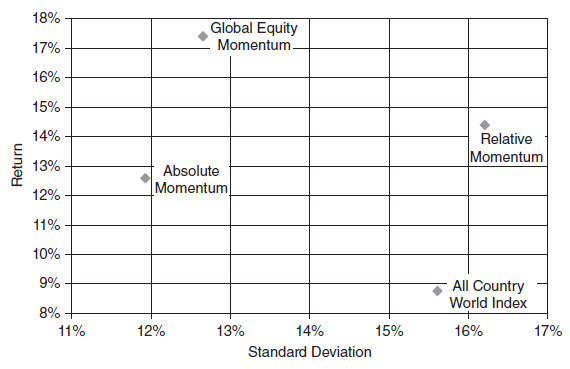Relative Strength of Indexes as a Future Return Indicator CXO Advisory
Post on: 29 Июнь, 2015 No Comment

A reader requested confirmation of findings in the article A Simple & Powerful Timing Indicator of May 2009, which examines the strength of the (risky) NASDAQ Composite Index relative to the (conservative) S&P 500 Index as a market timing indicator. The article cites the book Technical Analysis Power Tools For Active Investors (copyright 2005 and second printing date May 2005) as the source for the indicator. The indicator is the ratio of weekly index levels (risky-to-conservative) with respect to the ratios 10-week simple moving average (SMA). The associated trading rule is to move from cash (stocks) to stocks (cash) when the weekly ratio crosses above (below) its 10-week SMA. The argument is that a stronger (weaker) risky index indicates risk-on (risk-off) sentiment and therefore a strong (weak) stock market. Using weekly closes for the S&P 500 Index. the NASDAQ Composite Index. the dividend-adjusted SPDR S&P 500 (SPY) and the 13-week Treasury bill (T-bill) yield as available from mid-November 1992 (based on inception of SPY) through mid-August 2012, we find that:
In modeling the trading rule, we assume that:
- Based on weekly closes, when the ratio of the NASDAQ Composite Index to the S&P 500 Index crosses above (below) its 10-week SMA, buy (sell) SPY at the same close (crossing signals from just before the close are reliable).
- One-way trading friction when entering and exiting SPY is 0.1% of funds for the baseline case. Actual friction depends on specific broker fees, account size and market liquidity.
- When not in SPY, the return on cash is the T-bill yield.
- Reinvestment of SPY dividends is frictionless.
- For cumulative return calculations, use $100,000 as an initial investment.
- Ignore tax implications of trading.
The following chart summarizes average weekly returns over the entire sample period, with one standard deviation variability ranges, for: buying and holding SPY (SPY); applying the trading rule frictionlessly (Rule Gross); and, applying the trading rule with baseline trading friction (Rule Net). Results confirm that the trading rule captures essentially all of the SPY return with substantially lower variability.
Over this period, the trading rule generates 185 switching signals and is in stocks 55% of the time.
For another perspective, we look at cumulative values.
The next chart tracks the cumulative values of buying and holding SPY (SPY) and applying the trading rule with 0.1% switching friction over the entire sample period. Results indicate that the trading rule mostly outperforms buy-and-hold with lower volatility. However, its performance the last three years appears unattractive.
How sensitive is this outcome to level of trading friction?
The next chart shows how the net terminal value of the trading rule varies with levels of stocks-cash switching friction ranging from 0.00% to 0.30%. Based on this metric, the trading rule is attractive for very low switching friction but unattractive for switching frictions above about 0.15%. In other words, investors with small accounts may not be able to exploit the switching signals.

As a robustness test, we examine subperiods based on book and article publication dates.
The next chart summarizes average weekly returns for SPY, Rule Gross and Rule Net during three periods:
- The entire available sample period (Since Feb 1993).
- The subperiod after the second printing likely went to press (Since Jan 2005).
- The subperiod after the publication of the referenced article (Since Jun 2009).
The number of switching signals for the three periods are 185, 77 and 36, respectively. Results show that the rule performed well during the entire sample period and the longer subperiod, but it has performed poorly the past three years. Potential explanations include: (1) the recent subsample is unlucky; (2) rule performance is sensitive to the bull-bear ratio of the sample period; and, (3) investors have adapted to the rule and extinguished or reversed its effectiveness.
The recent very low return on cash relative to dividends may be material to rule performance since June 2009.
As a test of the underlying reason for trading rule effectiveness, we relate the size of the gap between the index ratio and its SMA to future stock market returns.
The following scatter plot relates next-week SPY return to the size of the gap between the weekly value of the NASDAQ Composite-S&P 500 ratio and its 10-week SMA (measured as a percentage of ratio value). If the gap measures a persistent investor risk appetite, the larger the magnitude of the gap, the stronger the implication for future stock returns.
The Pearson correlation between the two series is 0.02, and the R-squared statistic is 0.000, indicating no useful relationship. In other words, the size of the gap between the ratio of indexes and its 10-week SMA appears not to be useful for weekly trading of SPY. This finding does not support belief that investor risk appetite scales with relative strength of risky and conservative market indexes.
In summary, evidence from simple tests offers mixed support for belief that the intermediate-term strength of a risky stock index relative to a conservative index generates reliably profitable trading signals on a net basis. The rule is likely not beneficial for investors with small accounts.
Cautions regarding findings include:
- The pre-publication effectiveness of the trading rule may involve material data snooping bias derived from testing many signals on the same data. Trading rules may draw the most attention at times of peak effectiveness.
- The two recent subperiods since book and article publication dates are small in terms of number of bull and bear markets. Even the entire sample period may not capture a reliable bull-bear market conditions ratio.
Why not subscribe to our premium content?
It costs less than a single trading commission. Learn more here.














